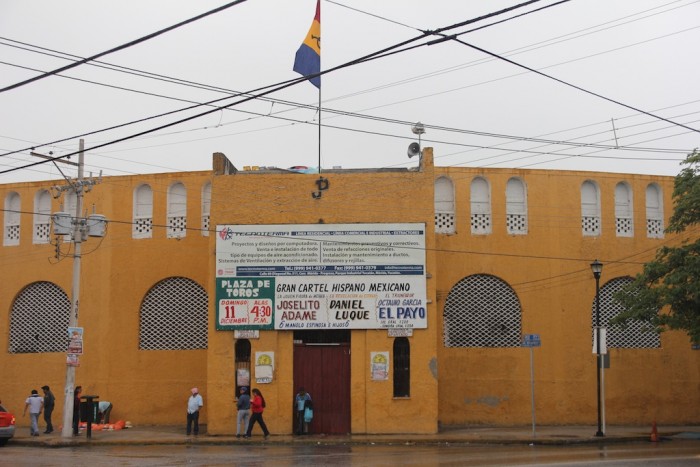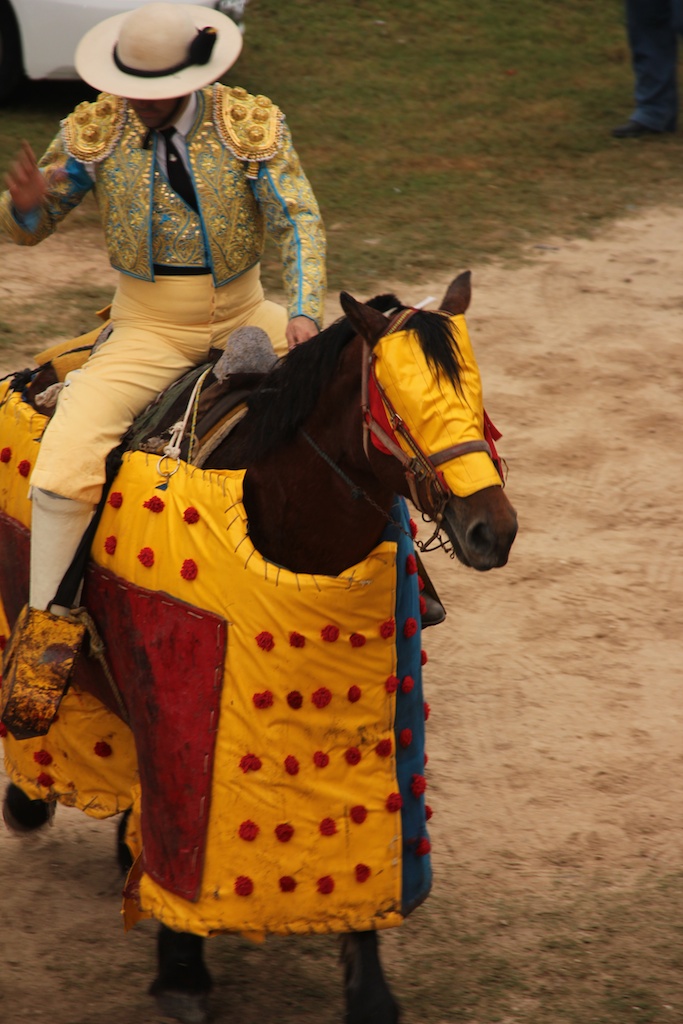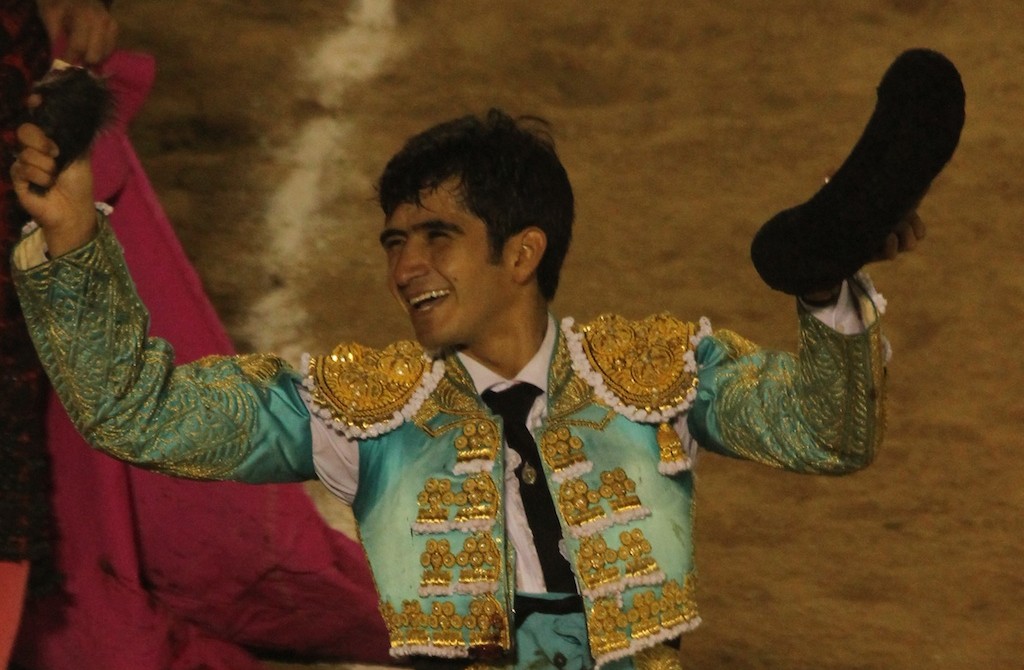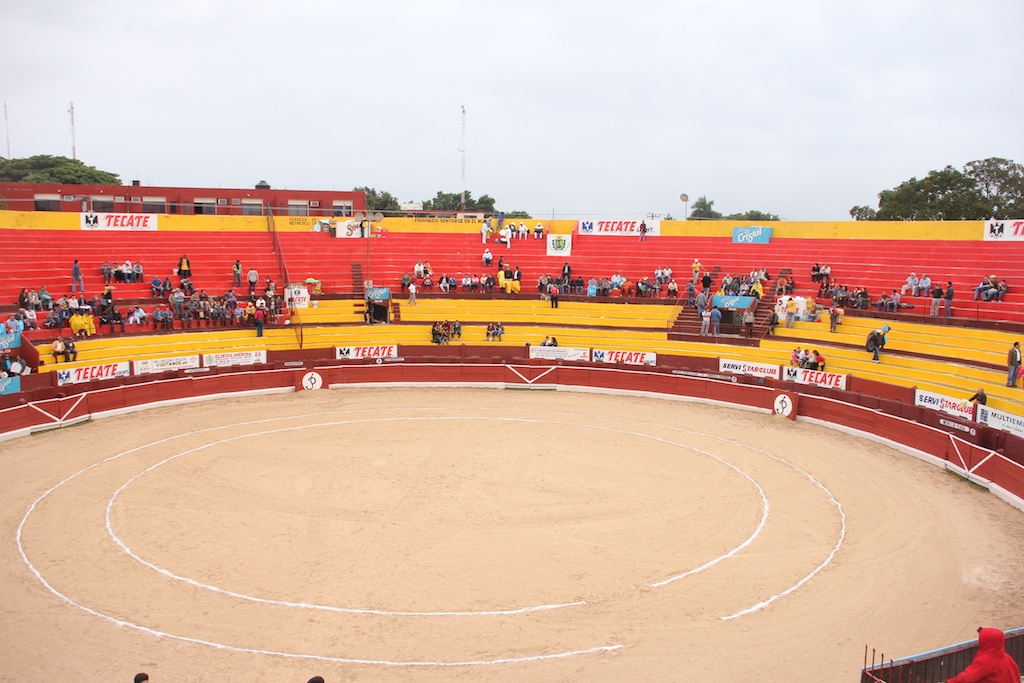
On Sunday, December 11th we followed through with our decision to attend a bullfight in Merida at the Plaza de Toros. This was a decision the entire family made together to see an event which may not always exist. I know that it is difficult to believe a 5 year old and a 7 year old were involved in the decision making process but after talking about the event for a couple of weeks and watching many uTube videos we all decided to go. I believe time will tell if they appreciated the art of the bullfight and if they will gain the understanding of the significance of seeing cultural events such as this.
There are many reasons to see a bullfight and I wish I was better educated on the art form of bullfighting before we went to see our first one. Here is some information regarding the bullfight which should be read before making the decision to view the event. It is the cultural experience we have decided to see, an event which has been around for hundreds of years but may not be around for ever. It is for this reason we chose to embrace the history of bullfighting and to try to appreciate the dance between the bull and the man.
The Plaza de Toros in Merida holds about 5,ooo people and is small enough that there really is not a bad seat available. Buying a ticket in the sombre “shade” is more expensive than a sol “sunny” ticket but we chose to save a little bit of our pesos and bought the less expensive sunny tickets in advance. It was a cloudy and rainy day so we did buy rain panchos (ranging from 20 pesos to 100 pesos) and seat cushions which were 20 pesos each. I keep finding the following quote when researching the history of bull fighting:
Ernest Hemingway said of it in his 1932 non-fiction book Death in the Afternoon:
“Bullfighting is the only art in which the artist is in danger of death and in which the degree of brilliance in the performance is left to the fighter’s honour.”
Bullfighting is seen as a symbol of Spanish culture.
At the beginning of the bullfight, you really get a chance to admire the history of the event and understand the cultural significance it portrays. In Merida there were three matadores, and each of them were to fight two bulls, each weighing more than 460kg. Each matador has six assistants: two picadores mounted on horseback; three banderilleros or toreros; and a mozo de espadas who is the sword carrier. The event starts with a parade into the ring to salute the presiding dignatary. The matadores costumes are inspired by 17th century Andalusian clothing and are very detailed. Then the bull is announced by a person holding up a sign with the bulls name on it and how much he weighs. As he exits the ring the bull charges in and the fight has started.
Three stages of the bullfight:
 The Tercio de Varas “the lancing third”
The Tercio de Varas “the lancing third”
- Bull entrance and tested for ferocity by the matadar and banderilleros with their capes
- A Picador on horseback with a vara “lance”, stabbing the bull behind the neck drawing the first blood
The Tercio de Banderillas “the third of banderillas”
- Each of the three banderilleros each attempt to plant two barbed sticks into the bulls shoulders
The Tercio de Muerte “the third of death”
- The matador re-enters the ring with a small red cape and a sword and performs many different moves used to wear the animal down before thrusting the sword between the bulls shoulders piercing its lungs or heart.
This is the short condensed version from Wikipedia, for more information on bullfighting please visit Spanish-style bullfighting.
The second bull of the day, ran into the ring and as it charged into the first wooden barrier it broke its horn. The crowd went crazy calling for the bull to be freed. The bull was allowed to leave the ring as it is not proper to fight with an injured animal. In rare cases where the bull has fought extremely well, the crowd can cheer and the bull may be granted a pardon which will spare its life and it can return to the ranch where it came from and be a stud for the rest of its life. We are not sure what happened to this bull but we believe it is back home on its ranch.
The third bull caught a piece of one of the banderilleros as he tried to run and hide behind the wooden barrier. Luckily the bull was more interested in the cape that was tangled in his horns than the banderilleros he had just tossed to the side. Noah thought that this was good because he liked that the fight was more fair because the bull had horns and could charge at the man.
 The next matador was very entertaining and put on a show for the crowd. This matador performed all of the steps in the bullfight himself which had the crowd waving their white handkerchiefs. This is apparently very rare but this matador was there to entertain and to perform his dance with the bull to the best of his ability. After performing the Tercio de Muerte, the president of the ring awarded this matador the ear of the bull as a trophy of his exceptional performance. The crowd loved this matador and he walked around the ring as they all threw hats and scarves and items into the ring showing their respect.
The next matador was very entertaining and put on a show for the crowd. This matador performed all of the steps in the bullfight himself which had the crowd waving their white handkerchiefs. This is apparently very rare but this matador was there to entertain and to perform his dance with the bull to the best of his ability. After performing the Tercio de Muerte, the president of the ring awarded this matador the ear of the bull as a trophy of his exceptional performance. The crowd loved this matador and he walked around the ring as they all threw hats and scarves and items into the ring showing their respect.
In retrospect, we are all glad we attended this event. We are not sure we will go to another one. Once may have been enough, but a day later we are still glad we attended this culturally significant event. I definitely believe that paying more money to see exceptional matadores is worth it as you can really see the history, culture, and training it takes to entertain at this level. The social experience in watching the people who frequently attend bullfights is amazing as they are watching every nuance and through them you can learn a lot about the art of the bullfight.
Yes, I took lots of pictures and videos. I may post them in the future or I may not. People should have the opportunity to decide if they wish to see these types of photos and videos and if I post them on this blog, I may be taking away their ability to make that choice.
The Plaza de Toros is located at the corner of Reforma and Calle 33 in the Garcia Gineres colonial. This is located very near the Hyatt Hotel and Fiesta Americana in Merida. The next event I believe is scheduled for January 1, 2012 at 4:30pm and the bull fighting season runs from November to March. Tickets are available at the Plaza de Toros in advance. We did find a link on FaceBook for the Plaza de Toros but this was the only online presence we could find leading up to the event.





I hope you do decide to publish them. Not that I want to see gore and violence, but I think it would be healthy to shed a little light on what happens in the bullring.
Good for you and your family for making the decision on your own terms to have a potentially challenging experience. I know feelings about bullfights run high but it’s your decision to make, and as you point out, they may not exist for much longer.
I was scared to open this post. I’m glad that you didn’t include more pictures or videos of the event. The cultural aspect is interesting. The costumes are beautiful. However, the bottom line is, the bull is dead. Put into perspective though, our highways are full of animals that have died in traffic, all the beef we eat in Alberta died first, and every year the hunters head out into nature to pursue game for meat and horns. So, I guess it needs to be put into perspective! Probably your dad will have a much different opinion of the matter than I do.
I do wonder though how Noah, who was scared to see the musical, The Wizard of Oz, last Christmas was brave enough to do this!
MOM
P.S. you don’t have to post my comments!
We went to Plaza de Toros this past weekend to see a bullfight. We had never seen one and I was not expecting it to be quite what it was. I guess I thought the matadores put on a show with the bulls charging at them. I never expected to see all the blood and the bulls die. We were glad for the experience – it is part of the Mexican culture. I don’t think I can go again. Like you, we took a lot of pictures but I didn’t post them for others on my blog to see. I enjoyed your blog and gained some new information that I didn’t know.
It is definitely a ‘once in a lifetime experience’ – and by that I do not mean that it is not possible to go to more than one bullfight, but people may not want to go a second time. As you can see I have still not posted more pictures on the site, and probably never will. I have not even shown them to visiting guests yet, although if a guest visiting us from Canada wanted to see them, I would show them the pictures.
Thank you for reading our blog!
Thank you very much for the article. I’ve just bought the ticket for tomorrow’s show (the one you were talking about) and I am really curious how it will be. Until I read your article, I don’t think I was truly prepared for seeing blood and dead animals, although I knew that is what I signed up for. But the story with the broken horn really put the things into perspective. I mean… Anything can happen there, so now I will be prepared for anything.